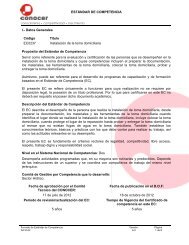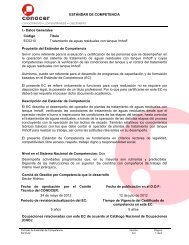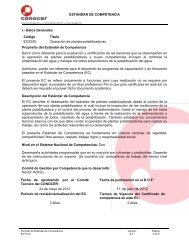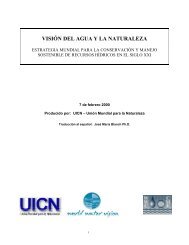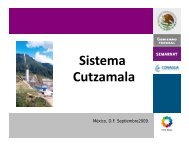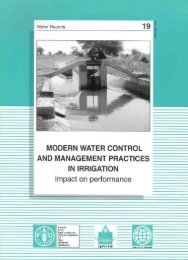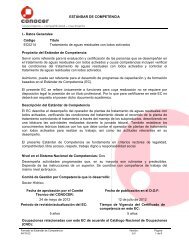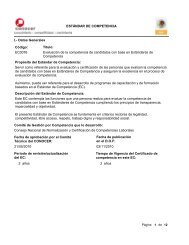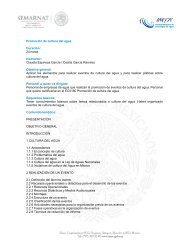Agricultural drainage water management in arid and semi ... - FAO.org
Agricultural drainage water management in arid and semi ... - FAO.org
Agricultural drainage water management in arid and semi ... - FAO.org
You also want an ePaper? Increase the reach of your titles
YUMPU automatically turns print PDFs into web optimized ePapers that Google loves.
14Def<strong>in</strong><strong>in</strong>g the problem <strong>and</strong> seek<strong>in</strong>g solutionscomponents us<strong>in</strong>g data collected by the<strong>water</strong> district. Furthermore, theydeveloped <strong>and</strong> evaluated spatiallydistributed <strong>dra<strong>in</strong>age</strong> <strong>water</strong> disposalcost<strong>in</strong>g strategies. The follow<strong>in</strong>g is a briefoverview of their research f<strong>in</strong>d<strong>in</strong>gs.FIGURE 5Topography <strong>and</strong> boundaries of the Panoche WaterDistrictThe Panoche Water District, situated<strong>in</strong> the western side of the San Joaqu<strong>in</strong>Valley, is a typical example of a <strong>water</strong>district that needs to cope with disposallimitation <strong>in</strong> the form of selenium loadtargets. Figure 5 shows that the districtlies on two alluvial fans <strong>and</strong> is generallyflat with slopes of not more than 1 percenttrend<strong>in</strong>g <strong>in</strong> a northeasterly direction.The ground<strong>water</strong> <strong>in</strong> the LittlePanoche Creek alluvial fan conta<strong>in</strong>ssodium-chloride type <strong>water</strong>, relatively low<strong>in</strong> salt content, <strong>and</strong> with seleniumconcentrations rang<strong>in</strong>g from 1 to 27µg/litre (Young <strong>and</strong> Wallender, 2000b).In contrast, the ground<strong>water</strong> <strong>in</strong> thePanoche Creek alluvial fan conta<strong>in</strong>ssodium-sulphate type <strong>water</strong>, relativelyhigh <strong>in</strong> salt content, <strong>and</strong> with seleniumconcentrations rang<strong>in</strong>g from 20 to400 µg/litre. Due to overirrigation s<strong>in</strong>cethe <strong>in</strong>troduction of surface <strong>water</strong> deliverysystems <strong>in</strong> the 1950s, the <strong>water</strong> tablerose to with<strong>in</strong> 1–3 m of the groundsurface. Subsurface <strong>dra<strong>in</strong>age</strong> was<strong>in</strong>stalled which ma<strong>in</strong>ta<strong>in</strong>ed successfullythe <strong>water</strong> table at an acceptable level foragriculture. However, due to irrigation<strong>and</strong> <strong>dra<strong>in</strong>age</strong> practices the naturallyoccurr<strong>in</strong>g salts <strong>and</strong> selenium <strong>in</strong> theregion’s soils are mobilized <strong>and</strong> enter <strong>in</strong>tothe subsurface <strong>dra<strong>in</strong>age</strong> system as wellas <strong>in</strong>to the shallow ground<strong>water</strong>.Calculation of a spatially distributed<strong>water</strong> balance revealed that downslopeareas with shallow <strong>water</strong> tables receiveground<strong>water</strong> discharge. Dra<strong>in</strong>s <strong>in</strong> theseareas <strong>in</strong>tercept lateral <strong>and</strong> verticalupward flow<strong>in</strong>g ground<strong>water</strong>, while theupslope undra<strong>in</strong>ed areas recharge to theground<strong>water</strong> (Figure 6). The highest saltload <strong>in</strong> the collected <strong>dra<strong>in</strong>age</strong> <strong>water</strong>Source: Young <strong>and</strong> Wallender, 2000a.FIGURE 6Annual recharge to ground<strong>water</strong> <strong>in</strong> Panoche WaterDistrictNmmSource: Young <strong>and</strong> Wallender, 2000a.1 0 1 2 3 KilometresSource: Young <strong>and</strong> Wallender, 2000a.-1200 - -800-800 - -400-400 - 0mm0 - 400400 - 800800 - 12001200 - 1600



